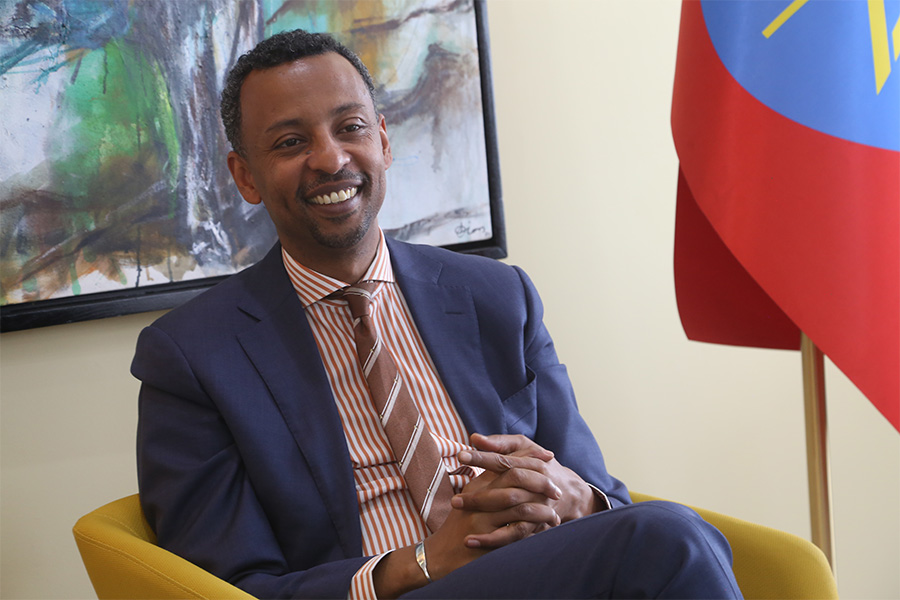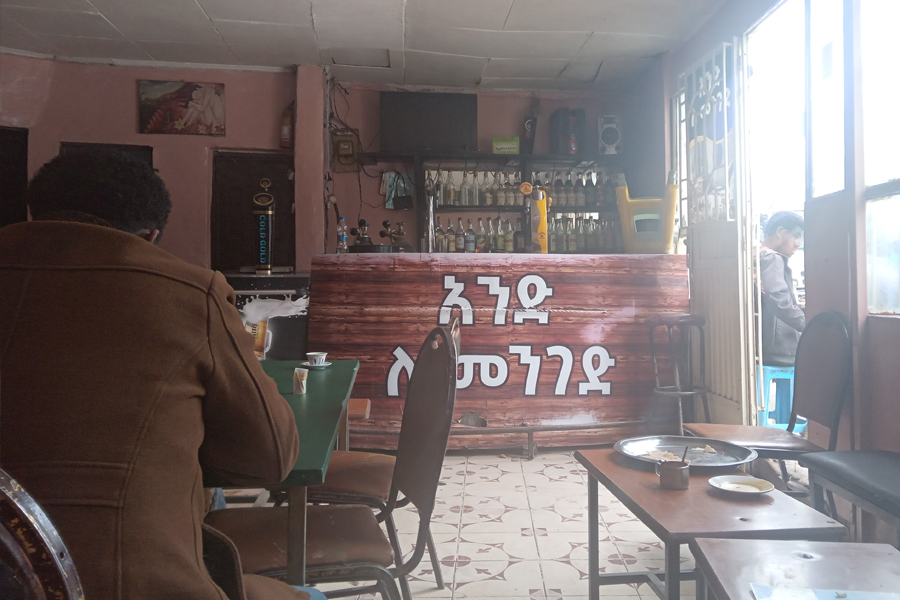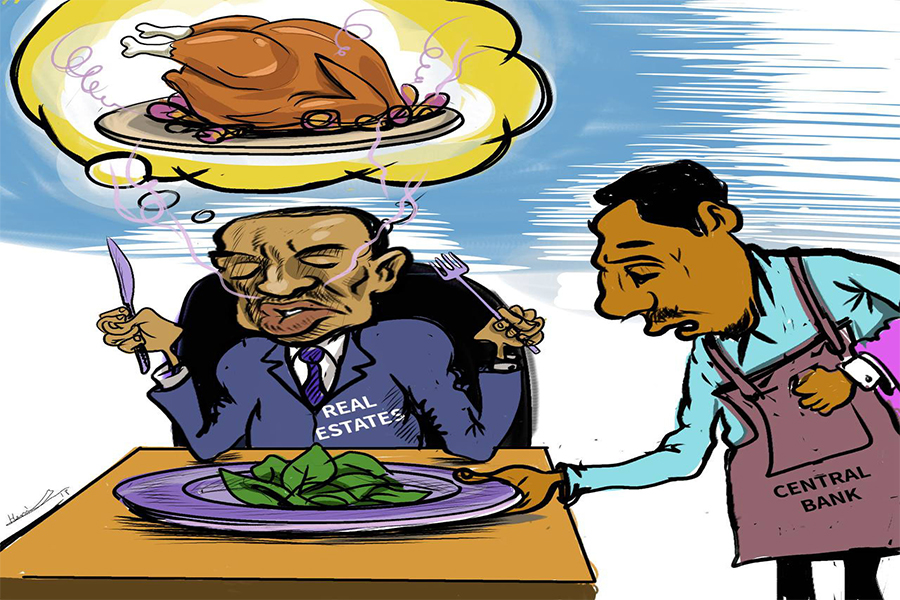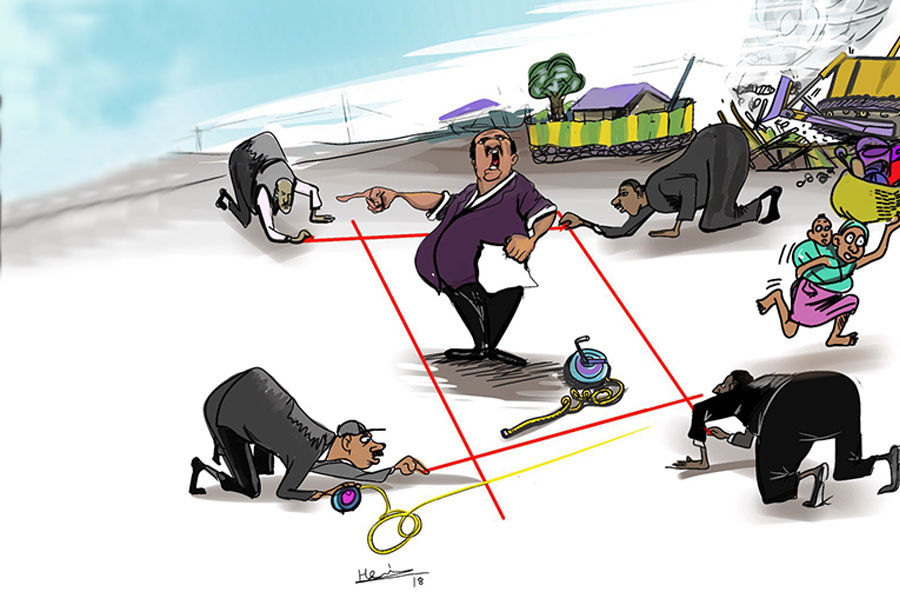Fenta Atele gazes at the shrinking shores of Lake Abaya, in Southern Regional State, worry etched on his face. Until recently, the lake’s plentiful water allowed him and his fellow farmers to irrigate their thriving crops of bananas, onions, vegetables, wheat, and fruits. Today, however, he is wrestling with an economic crisis sparked by rising fuel costs.
He used to earn 200,000 Br monthly when fuel prices were below 30 Br a litre. Now that retail gas prices have climbed steeply, Fenta’s farm is sliding towards unexpected losses.
“I’ve tried maintaining my previous production levels,” he said. “But, I can't keep pace with these economic difficulties and the technological advancements.”
Fenta and his colleagues had relied on one fuel-powered pump to irrigate their land. With the lake receding, two pumps are now required, doubling fuel expenses. His only real alternative — solar-powered irrigation — is unaffordable, with pump prices ranging from half a million to over one million Birr.
"I struggle daily with fuel costs," Fenta told Fortune. "If I can't afford a solar pump, I’ll have no choice but to stop irrigating."
Solar irrigation is seen as a revolutionary solution to Ethiopia's agricultural struggles, particularly amid escalating fuel prices and unreliable traditional irrigation methods. However, the prohibitive initial costs, technical issues, and limited skills have kept many of the 19 million farmers like Fenta on the sidelines.
A short distance away, Behailu Abbota has had some success, farming banana, switching partly to solar irrigation. Farming in Arba Minch’s hot climate, Behailu depends heavily on frequent watering for his six hectares of banana farm. Previously, he ran four gas generators daily, consuming about 30Lts of fuel. After investing 300,000 Br in a solar pump last year, his daily fuel consumption has gone down to zero.
Around one million diesel pumps are in use, although this number has declined due to high spare parts and diesel costs. In the last six months of the current fiscal year, 66,648 water pumps were imported, signalling that the year will see much lower import numbers compared to 235,000 in 2023/24 and 238,411 the year before.
Behailu recalled the financial constraints facing other farmers despite clear savings from solar-powered pumps.
"My colleagues want to switch, but now the price has doubled," he lamented. "It's unaffordable."
Solar pumps also present practical issues. They only operate during daylight hours unless connected to electricity.
"Without sunlight, you can’t run the pump," he said.
Take Misganu Sete, who cultivates mangoes and vegetables in Armachho Mdregenet. He bought his solar pump four months ago for half a million Birr. Despite substantial fuel savings, he is disappointed by the technology's limited usability.
"You can only use it during daylight," he said.
He spent heavily on fuel last year, but this year’s savings have not significantly boosted production yet.
Further north in Butajira East Miskan Woreda, Central Ethiopia Regional State, Ibrahim Erede shares Behailu's cautious optimism. He grows fruits and vegetables across three hectares using a solar pump. It pumps water effortlessly from depths exceeding 20 metres, delivering nine litres a second. Yet, he admitted the investment — 1.8 million Br, partly funded by a Dutch company — is out of reach for most.
"Initially, farmers hesitated," he recalled. "I convinced some to adopt it. We’re now growing a diverse range of crops."
However, many in his village still can not afford solar pumps, especially with rising prices.
Across Ethiopia, similar stories emerge where financial realities temper optimism. Abebe Goshu, managing water resources in Wetet Abay District, sees solar pumps as critical in addressing local drinking water shortages. Yet, even with international aid reducing costs, financial strain persists.
"Without sufficient sunlight, the pump can't run, and the cost remains high," he said, noting they reduced fuel expenditure but still face limitations.
There are over 1,500 solar pumps across the country for irrigation; however, this figure also includes community-based efforts. Where Zelalem Girma sits as a manager of Meseret Mare Gebre Solar Importer, uptake has been slow despite importing around 250 solar water pumps since 2020. Prices in Ethiopia are disproportionately high compared to neighbouring countries. A pump that costs between 400,000 and half a million Birr in Kenya can be up to 1.2 million. Customs tariffs and VAT add to the cost of building solar pumps, making them unaffordable for many smallholders.
Those from the International Water Management Institute confirm these observations.
"Solar pumps in Ethiopia cost three times more than in Kenya," Muluken Eliyas (PhD), deputy country representative of the Institute and a researcher, said. "The dynamics are not progressing as swiftly as we'd prefer."
A recent research on solar pump irrigation discovered the viability and prospects of photovoltaic solar pumps for smallholder irrigation, revealing that approximately 1.4 million farmers are engaged in small-scale irrigated agriculture, with 210,000 to 400,000 leveraging motor pumps. Ethiopia imported motor pumps valued at 10 million dollars in 2012, comprising a notable portion of the 70 million allocated for irrigation equipment imports. The research had forecasted this figure would have increased by 10-fold if Ethiopia realised its irrigation objectives by 2020.
It appears an ambition far from realisation. Despite distributing 20,000 pumps this year for farmers in the Oromia Regional State, only a fraction were solar-powered.
"Farmers remain committed to fuel-based irrigation," said Meskelu Tulu, the State's director for mechanisation.
For Mitiku Africa, director of mechanisation in the Southwest Regional State, another of the most pressing problems is finding skilled technicians.
"Fuel costs hinder irrigation, yet solar technology is also problematic without skilled support," he told Fortune.
Solar importer Agri Sun Ethiopia has supplied over 500 pumps nationwide in the past two years, bridging financial gaps through partnerships with banks and international agencies. Its General Manager, Yimam Kebede, conceded farmers still face affordability barriers.
"They want these pumps but buying them isn't easy," he said. "Convincing them of solar technology's benefits requires considerable effort."
The Ethiopian Solar Energy Development Association (ESEDA), representing 99 members, advocates for broader solar adoption. According to Yemissrach Sisay, its general manager, financial models currently available from banks and microfinance institutions are inadequate.
"Policy adjustments are essential," she argued.
Without dedicated loans, widespread adoption will remain elusive.
Federal officials responsible for agricultural, rural and lowland communities acknowledge the potential of irrigation. According to Elias Awol, head of smallholder irrigation development at the Ministry of Agriculture, improvements in solar pump adoption, particularly through partnerships with international institutions like the World Bank and the International Fund for Agricultural Development (IFAD). Yet, affordability remains worrisome.
"Transitioning farmers to solar irrigation involves financial and technological limitations," Elias said. “We aim for collateral-free loans to support them."
Abdurahman Abdela, state minister for Irrigation & Lowlands, sees solar irrigation as essential for achieving Ethiopia’s agricultural goals.
"Fuel pumps lack durability and efficiency," he told Fortune.
Despite ambitious government initiatives, such as a seven-year, 60 million-dollar solar irrigation project, practical difficulties for wider use persist. Federal officials have the ambitious goal of reaching 50pc solar pump adoption by 2030. Partnerships with the World Bank and the Development Bank of Ethiopia (DBE) aspire to address financial issues, but the real impact will take time.
Yared Mulat, a lead executive for irrigation project research and design at the Irrigation & Lowlands Ministry disclosed that there are 11 major projects across the country, exceeding 100 million Br in investment. One project in the Waghmira Zone, Amhara Regional State, has the potential to irrigate 3,500hct, with over 1,000hct utilising solar energy. The Ministry has secured a 450 million dollars financial package from the World Bank for various projects, which includes solar pump initiatives.
The private sector's engagement in solar energy development is on the rise, noted Birhanu Wolde, Rular Energy Development lead excecutive at the Ministry of Water & Energy, who sees the dual barriers of affordability and technological limitations.
"Farmers need practical demonstrations, not simply theoretical benefits," he said.
Solar experts point to another dimension in technical literacy.
"Implementing solar irrigation requires skilled personnel and better technological understanding among farmers," said Seyfie Abate, an expert in the industry.
Davis & Shirtliff Trading Ethiopia, the country's largest importer, annually imports around 2,000 solar pumps, demonstrating increasing demand but also revealing ongoing implementation issues, According to Seyfie.
The Adventist Development & Relief Agency (ADRA), an international non-governmental organisation, trains young professionals in the solar industry, integrating them into the agricultural domain. According to Getachew Mitku (PhD), Green TVET project assistant at ADRA, partnering with the Ministry of Labour and through the development of educational materials, the organisation provides short-term training courses.
"Introducing solar will not rectify the situation without adequately educated manpower," he told Fortune. "We're committed to bridging this gap."
ADRA has trained 480 individuals in Arbaminch, Wulqite, Afar, and Diredwa. Prior to the disruptions in the north, they planned to train 1,200 individuals in Oromia Regional State, though only 560 were admitted. Similar plans in Tigray faltered.
"We also train farmers on maintenance, yet the numbers remain insufficient," Getachew said. "Once trainees complete their programme, pathways to workforce integration are facilitated."
However, small number of importers, inadequate foreign exchange, and limited credit access remain critical barriers.
Yemanebrhan Kiros, manager of Yomener Energy, sums up the dilemma facing Ethiopian agriculture. Despite the clear financial and environmental benefits of solar irrigation, Ethiopia’s farmers remain trapped between the costs of fuel and solar technology.
"How can a farmer financially transition to solar while initial solar costs are steep, daily operational expenses are minimal compared to fuel," he quipped. "Yet, affordability remains a barrier for most."
Many farmers, like Fenta, stare into an uncertain future, waiting for affordable and practical solutions. Experts in the field see the promise of solar irrigation tangled in financial and technical complexities, which requires more than technological innovation. They urge strategic economic reform, practical financial solutions, and comprehensive technical training. Until then, farmers' hopes remain illuminated but still distant.
PUBLISHED ON
Mar 16, 2025 [ VOL
25 , NO
1298]

Dec 22 , 2024 . By TIZITA SHEWAFERAW
Charged with transforming colossal state-owned enterprises into modern and competitiv...

Aug 18 , 2024 . By AKSAH ITALO
Although predictable Yonas Zerihun's job in the ride-hailing service is not immune to...

Jul 28 , 2024 . By TIZITA SHEWAFERAW
Unhabitual, perhaps too many, Samuel Gebreyohannes, 38, used to occasionally enjoy a couple of beers at breakfast. However, he recently swit...

Jul 13 , 2024 . By AKSAH ITALO
Investors who rely on tractors, trucks, and field vehicles for commuting, transporting commodities, and f...

Oct 11 , 2025
Ladislas Farago, a roving Associated Press (AP) correspondent, arrived in Ethiopia in...

Oct 4 , 2025
Eyob Tekalegn (PhD) had been in the Governor's chair for only weeks when, on Septembe...

Sep 27 , 2025
Four years into an experiment with “shock therapy” in education, the national moo...

Sep 20 , 2025
Getachew Reda's return to the national stage was always going to stir attention. Once...